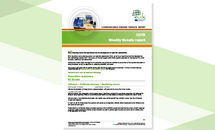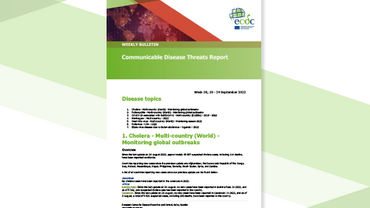Communicable disease threats report, 11-17 September 2016, week 37
The ECDC Communicable Disease Threats Report (CDTR) is a weekly bulletin for epidemiologists and health professionals on active public health threats. This issue covers the period 11-17 September 2016 and includes updates on Zika virus, West Nile fever and MERS.
Executive summary
This issue covers the period 11–17 September 2016 and includes updates on Zika virus, Middle East respiratory syndrome – coronavirus (MERS-CoV) and West Nile fever.
Zika virus infection outbreak
Since 2015, and as of 15 September 2016, there have been 64 countries and territories reporting mosquito-borne transmission.
Among EU Member States, and since week 45/2015, 19 countries (Austria, Belgium, Czech Republic, Denmark, Finland, France, Ireland, Italy, Luxembourg, Malta, Netherlands, Norway, Portugal, Romania, Slovakia, Slovenia, Spain, Sweden, United Kingdom) have reported 1 614 travel-associated Zika virus infections through The European Surveillance System (TESSy). This corresponds to an increase of 57 cases since the last update. Since week 45/2015, seven EU countries reported 80 Zika cases among pregnant women.
In Florida, USA, 22 new locally-acquired cases have been reported since the last CDTR. In Asia, specifically in Singapore, Malaysia and Thailand continue to report locally-acquired cases.
ECDC publishes an epidemiological update every Friday and continues to update maps containing information on countries or territories which have reported confirmed autochthonous cases of Zika virus infection. Zika Atlas is available on ECDC website.
The latest ECDC Rapid Risk Assessment update was published on 31 August.
Middle East respiratory syndrome – coronavirus (MERS CoV)
Since the last update of MERS-CoV on 11 August 2016 and as of 15 September 2016, there have been eight cases and two additional deaths reported. The cases were reported by Saudi Arabia (6 autochthonous cases), Thailand (1 imported ex Kuwait) and Austria (1 imported ex Saudi Arabia).
According to WHO press release on the 14 September 2016, no cases of MERS-CoV were detected among the pilgrims participating the Hajj, which took place from 9-14 September 2016 in Mecca, Saudi Arabia.
ECDC's conclusion continues to be that the MERS-CoV outbreak poses a low risk to the EU, as stated in the Rapid Risk Assessment published regarding the last case in Austria on 16 October 2014.
West Nile virus – monitoring season 2016
In the past week, Austria reported a new case, whose place of infection is still under investigation. Spain reported a new case, in the already affected province of Sevilla.
In the neighbouring countries, Israel reported four new cases; Russia 26 confirmed cases; Serbia reported five new confirmed cases and Ukraine reported its first case of WNF for 2016 transmission season, a probable case in the region of Cheras’ka.
To date, there are 111 West Nile fever cases in humans have been reported among EU Member States and 181 cases in neighbouring countries.
ECDC produces weekly West Nile fever maps during the transmission season (typically June to November) to inform blood safety authorities of affected areas.
Download






